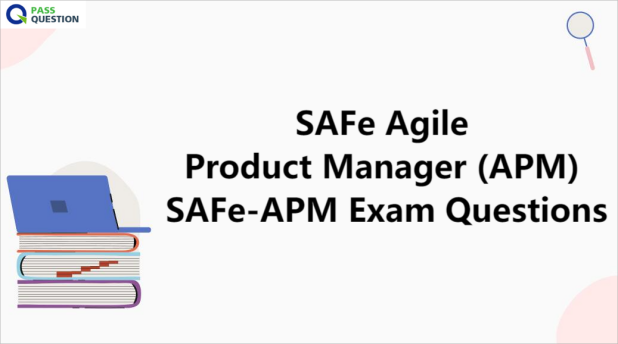SAFe Agile Product Manager (APM) SAFe-APM Exam Questions
Are you gearing up to take on the SAFe-APM SAFe Agile Product Manager (APM 6.0) exam? If so, we have a resource to help you prepare effectively and boost your confidence before entering the examination room. PassQuestion offers the most recent SAFe Agile Product Manager (APM) SAFe-APM Exam Questions, designed to cover all the essential topics that will be tested in the exam. By using PassQuestion SAFe Agile Product Manager (APM) SAFe-APM Exam Questions, you will gain a thorough understanding of the subject matter, increase your chances of success, and pass your exam with relative ease. Start your preparation today and gain the edge you need to excel in your SAFe-APM exam.

SAFe Agile Product Manager (APM 6.0)
In SAFe, product managers play a key role in the trio of leaders, including architects and the Release Train Engineer. These roles work together to lead the Agile Release Trains (ARTs) in continuously delivering value. In the Agile Product Management course, you'll explore how to use design thinking to put your customers at the center and create products that are desirable, feasible, and sustainable. You'll discover how continuous exploration fuels innovation. And you’ll explore how to define a vision, strategy, and roadmap to satisfy existing customers and attract new ones.
Exam Information
Duration: 120 minutes
Number of Questions: 60
Passing Score: 75%
Delivery: Web-based, closed book, no outside assistance
Retake Fee: $50
Exam Domains and Topics
Product Manager Role in the Lean Enterprise (11-13%)
- Product Manager's Role and Responsibilities
- Product Management Stakeholders and Collaborators
- Design Thinking
Continuous Exploration of Markets and Users (12-14%)
- Market Research and Continuous Exploration
- Hypotheses and Questioning
- Data-driven Practices for Solutions
- Research Planning
- Research Games for Customer Understanding
Market Segmentation Strategies (11-13%)
- Market Segmentation
- Market segment Value and Fit
Empathy-driven Design (7-9%)
- Persona Purpose, Creation, and Uses
- Empathy-driven Customer Experience
Product Strategy and Vision (12-14%)
- Product/Solution Purpose and Vision
- Value Propositions and Business Models
- Customer Journey Mapping
- Product and Solution Context
- Platform, API, and Data Strategy
Roadmap Creation to Build Solutions (11-13%)
- Solution Intent
- Market-driven Roadmaps
- Balanced Solution-based Features
- Features, Stories, and Story Maps
Value Delivery (14-16%)
- The ART Kanban
- The ART Backlog
- PI Planning
- PI Execution
Innovation Creation in the Value Stream (12-14%)
- Value Stream and Product Innovation
- Innovation Metrics
- Epics
- Funding Innovation
- Rapid Experimentation Application and Hypothesis Outcomes
View Online SAFe Agile Product Manager (APM 6.0) SAFe-APM Free Questions
1. Where are opportunities found in the strategic sweet spot?
A.Solution Intent
B.Competitors offerings
C.Product Vision
D.Customer needs
Answer: D
2. Which artifact do Product Managers create to facilitate alignment with Product Owners (POs) working on the same ART?
A.Team-level Backlogs
B.Strategic Themes
C.Enterprise Architecture Diagrams
D.Roadmap
Answer: D
3. Which element of Solution Intent helps drive a Solution Roadmap?
A.Specifications
B.Product Vision
C.Customer segments
D.Strategic Themes
Answer: B
4. When calculating Weighted Shortest Job First (WSJF), what action should be taken?
A.Execute one column at a time in full, then move on to the next
B.Set your 'ceiling' in Fibonacci and work down to the lowest-scoring item
C.Put each team in its own WSJF bucket
D.Perform individual sizing by role in isolation, then synchronize the scoring later
Answer: B
5. Which stakeholder(s) could best provide current business feedback to guide Feature enhancements?
A.Business Owners
B.Lean Portfolio Management
C.Solution Architect/Engineering
D.Product Owner (PO)
Answer: A
6. Which factor must be included when building a model of market segment value?
A.Number of servers it will take to deliver the value
B.Number of product distributors
C.Number of existing competitors
D.Number of product configurations that will be offered
Answer: C
7. What information does a Product Manager contribute during PI Planning?
A.Product Vision and Roadmap
B.Sizing of Features requested
C.The exact sequence of work
D.Definition of done for each Feature
Answer: A
8. What is a key factor in determining the value of a market segment?
A. Where the products and services will be sold
B. Availability of materials and people in sufficient quantities
C. The amount Customers are willing to pay for products or services
D. Time criticality in product delivery
Answer: C
9. What aspect of a product or service does the "Golden Circle" consider most important to communicate to prospective Customers?
A. The array of benefits the product or service offers
B. The product or service that sets it apart from others
C. The purpose of the product or service
D. The Solution that the product or service provides
Answer: C
10. Which is a good example of a pivot that would indicate that Customers want to pay in a different way?
A. Customer problem pivot
B. Customer segment pivot
C. Value exchange pivot
D. Feature pivot
Answer: C
- TOP 50 Exam Questions
-
Exam
All copyrights reserved 2025 PassQuestion NETWORK CO.,LIMITED. All Rights Reserved.

